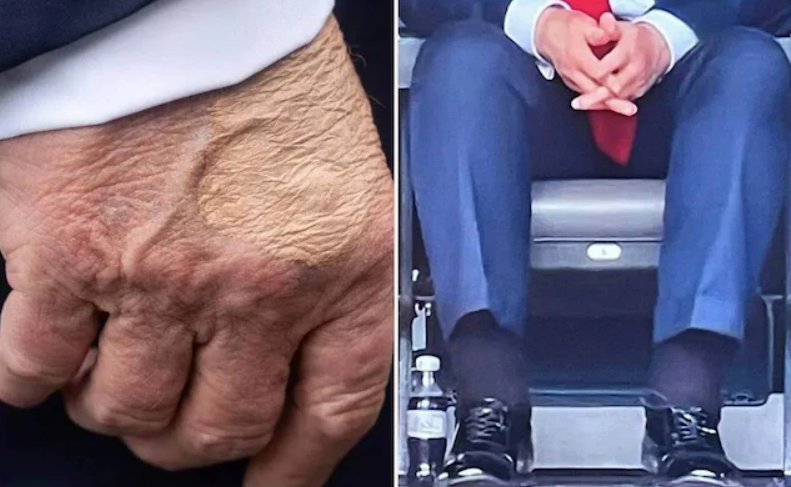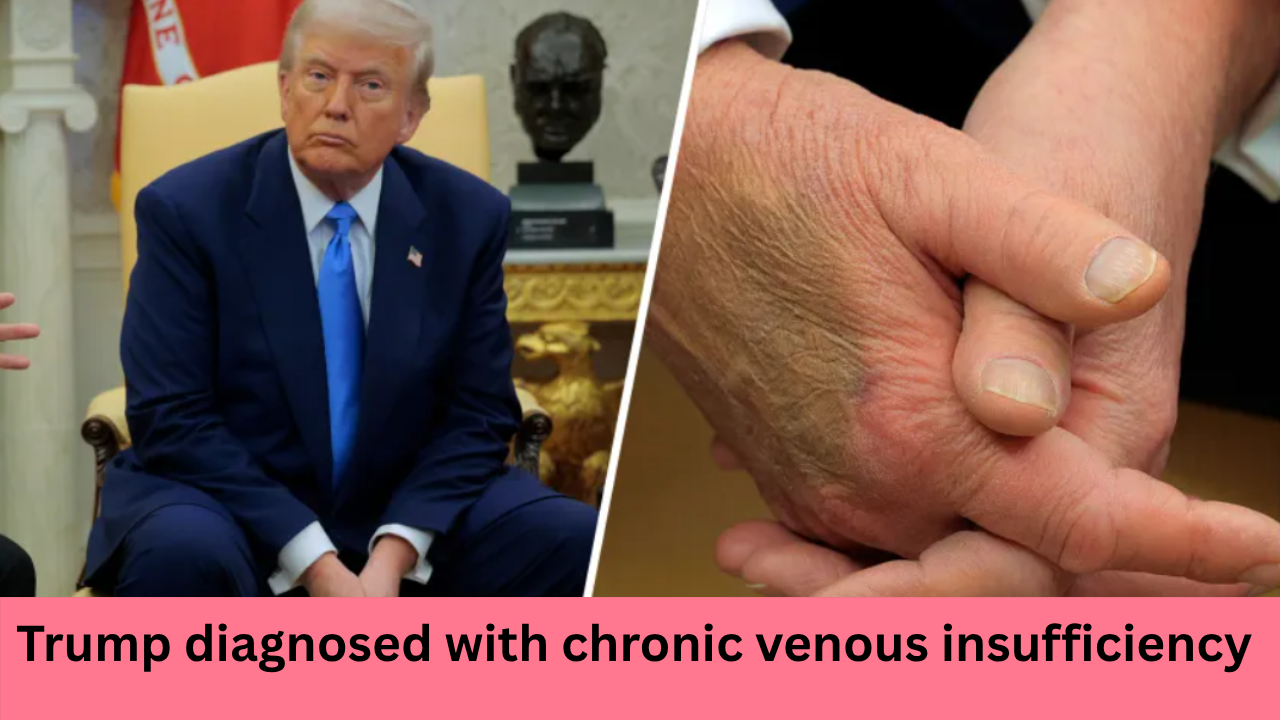President Donald Trump has been diagnosed with chronic venous insufficiency (CVI). Learn what this common vein condition means, how it’s treated, and why doctors say Trump remains in excellent health.
Former President Donald Trump has been officially diagnosed with chronic venous insufficiency (CVI), a circulatory condition affecting the legs, after undergoing medical tests for leg swelling and hand bruising, according to a statement from the White House. While the news has raised questions about his health, Trump’s physician has clarified that there are no signs of deep vein thrombosis (DVT), arterial disease, or any serious complications. Here’s what we know so far and what the condition actually means for Trump’s overall well-being.

Trump’s Diagnosis: What the White House Revealed
White House Press Secretary Karoline Leavitt confirmed the diagnosis on Thursday, stating that President Trump had reported mild leg discomfort and swelling over a few weeks. A full medical evaluation was subsequently performed.
The official health update was shared publicly through a letter by Dr. Sean Barbabella, Trump’s physician, who emphasized that:
- There were no signs of deep vein thrombosis (a potentially dangerous blood clot in a deep vein),
- No arterial disease was present,
- And all lab values were within normal limits.
Additionally, an echocardiogram showed normal heart structure and function, ruling out any cardiac concerns.
The President, now 79, also had some bruising on his hand, which Dr. Barbabella attributed to minor soft tissue irritation from frequent handshakes and regular aspirin use—a standard part of cardiovascular preventive care.
What Is Chronic Venous Insufficiency (CVI)?
Chronic Venous Insufficiency (CVI) is a circulatory condition that occurs when the veins in the legs become weakened or damaged, especially the small valves that regulate blood flow. These valves are supposed to keep blood moving upward toward the heart, but when they malfunction, blood flows backward (a process called venous reflux) and pools in the legs.
How CVI Develops:
According to Cleveland Clinic, the condition is commonly triggered by:
- Weakened or damaged vein valves
- A history of blood clots
- Prolonged standing or sitting
- Obesity or lack of physical activity
- Age-related wear and tear on veins
When blood pools in the lower extremities, it causes swelling, pressure, and discomfort, primarily in the ankles, feet, and calves.
How Common Is CVI?
CVI is relatively common, especially among older adults. Estimates suggest that up to 40% of people over age 50 may experience symptoms of CVI to varying degrees.
- It affects 1 in 3 adults according to Cleveland Clinic.
- The risk increases with age, with men and women over 70 years being more susceptible.
- It is not considered rare or life-threatening, especially when caught early and managed appropriately.

Dr. Barbabella noted that Trump’s case reflects a “benign and common condition”, particularly in older adults, and does not currently impact his ability to perform presidential duties.
Common Symptoms of CVI
Trump’s complaint of leg swelling aligns with typical CVI symptoms. But what are the other signs of this condition?
According to the American Heart Association, symptoms of CVI include:
Primary Symptoms:
- Swelling in the legs, especially around the ankles and feet
- Heaviness or tiredness in the legs
- Aching, throbbing, or cramping
- Itching or tingling sensation
- Restlessness in the legs, particularly at night
- Visible varicose veins
Advanced Symptoms:
- Red, flaky, or itchy skin on the lower legs
- Discoloration or thickening of skin
- Open sores or ulcers, especially around the ankles
- Bleeding or bruising, often from minor impacts
In Trump’s case, the bruising on his hand was not related to CVI but rather from routine physical interactions and aspirin use, which can increase susceptibility to minor bleeding.

Is CVI a Serious Condition?
The answer is: not usually, but it can become serious if left untreated.
CVI is categorized as a chronic but manageable circulatory issue. In early stages, symptoms are mild and may not significantly affect daily life. However, without treatment or lifestyle changes, the condition can worsen.
Potential Complications:
- Venous ulcers – painful open sores that are difficult to heal
- Cellulitis – a bacterial skin infection caused by fluid buildup
- Deep Vein Thrombosis (DVT) – a blood clot in a deep vein, which can lead to pulmonary embolism (a life-threatening blockage in the lungs)
Fortunately, Trump’s doctor confirmed that none of these complications are present in his case.
“This is not a debilitating or high-risk diagnosis,” Dr. Barbabella emphasized, affirming that the President remains in excellent health overall.
Swollen ankles at the World Cup
— Maine (@TheMaineWonk) July 15, 2025
Bruised hand at today’s press availability.
Is the Trump administration hiding the President’s health?
Where is @jaketapper? pic.twitter.com/SRo0bpJReK
How Is CVI Treated?
1. Compression Therapy (First-Line Treatment)
One of the most effective early treatments is the use of compression stockings, which help push blood up from the legs toward the heart, reducing swelling and pain.
- Trump is likely now wearing custom compression socks during the day.
- They are often used long-term, especially in older individuals.
2. Lifestyle Modifications
Doctors often recommend:
- Regular walking or leg exercises
- Elevating the legs several times a day
- Weight management for overweight individuals
- Avoiding prolonged standing or sitting
These habits can improve circulation and reduce blood pooling in the lower legs.
3. Advanced Therapies for Severe Cases
If symptoms worsen or don’t improve with conservative care, more invasive options are available:
Thermal Ablation:
- A catheter delivers heat to the vein, sealing it shut.
- Blood is rerouted through healthier veins.
Sclerotherapy:
- A chemical is injected into the affected vein.
- It causes the vein to collapse and eventually disappear.
These procedures are typically minimally invasive and performed in outpatient settings.
Trump’s Overall Health Status
Despite the diagnosis, the White House has made it clear that President Trump’s health is stable and that he is fit to continue his presidential duties without interruption.

Key points from his health report include:
- No signs of DVT or arterial disease
- Normal lab results
- Normal echocardiogram
- No systemic illnesses or kidney problems
- Good cardiovascular condition
Dr. Barbabella reassured the public that Trump remains in “excellent overall health,” and CVI is being managed effectively.
What This Means for the Future
While the news of Trump’s diagnosis may cause concern among supporters and opponents alike—especially during a politically active period—it’s important to recognize that CVI is highly treatable and rarely interferes with daily functioning when properly managed.
Given that:
- Trump has no other vascular or cardiac issues,
- He’s already undergoing appropriate treatment, and
- The condition is classified as mild,
There is no immediate cause for alarm or disruption to his public schedule.
No Major Cause for Concern
Chronic Venous Insufficiency may sound serious, but in reality, it’s a common condition among older adults and can be managed with routine care and attention. President Trump’s diagnosis is not uncommon for someone his age, and the lack of dangerous complications is a reassuring sign.
As with many chronic conditions, early detection and proactive management are key, and Trump appears to be following medical advice closely. Whether or not this will factor into his political future remains speculative, but as far as health goes—Trump is in the clear for now.
Also Read :
GENIUS Act Passes Crucial Vote Despite Trump’s Ineffective Crypto Council
Alaska on Edge: 7.3 Earthquake Strikes Near Sand Point, Sparks Tsunami Concerns
Andy Byron’s Wife Shockingly Drops His Surname After Viral Video with HR Head Surfaces
Elsie Hewitt Expecting First Baby with Pete Davidson: A Sweet Timeline of Their Romance

